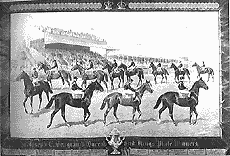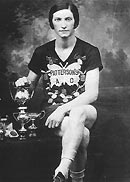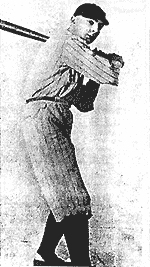|
York's early citizens have little time for organized entertainment. York is a market town for a rural constituency, and the game is survival. The only time out is during the winter months when the crops have been harvested. Mrs. Simcoe writes in her diaries about sleigh rides, ice fishing, and hours of visiting and chatter. When organized sport arrives, it belongs to the upper classes and is British in origin. The Toronto Cricket Club is North America's oldest, founded by British soldiers in the 1800s.
 |
|
Hanlan's Reception, 1879, by F.M. Bell-Smith |
Water sports are a big draw. By 1854 the Toronto Yacht Club had become Royal. It isn't until 1848 that the first recorded rowing race takes place, and Toronto is home to a World Champion. Ned Hanlan, the bootlegging son of Irish parents, rows his way into the gentlemen's sport and in 1876 beats the Americans. Three years later he wins the British Championship, becoming Canada's first international sports hero. His home-coming is the local event of the decade.
 |
|
Seagram Queens Plate, 1905 by Arthur H. Hider |
Another English sport is horse racing. The Carelton Race Track is built in 1857 at Dundas and Keele, and hosts the first running of the Queen's Plate in 1859. The purse is 50 guineas. A hundred years later, businessman E.P. Taylor's champion horse, Northern Dancer, wins the coveted Kentucky Derby. More than two thirds of the world's best thoroughbreds will be descend from Northern Dancer.
By mid century, sports is veering away from the privilege of the upper classes. Home grown games are attracting attention and democratizing participation. The Native sport of Lacrosse becomes all the rage in the 1850s. When Oscar Wilde attends a Toronto match, the city fathers brighten with pride as he gushes about the good looks of one of the home team boys.
The American game of Baseball proves a real crowd pleaser; by 1875 two Toronto teams, the Clippers and the Dauntless, are slugging it out. The Maple Leaf Baseball Stadium emerges in 1920 but the team disappears from Toronto until the creation of the Blue Jays in 1977, who become two time World Series Champs. Clearly, at the turn of the century indigenous sports are eclipsing British ones in popularity. Athletes become our idols.
 |
|
Ted Reeve, Middle Wing |
Long before "professional" sports and athletes make their appearance with big deals and big venues, varsity sports are the main Toronto attraction. High school baseball games at Willowdale Park, inter-city matches at the Beaches; football at Varsity Stadium, draw thousands of fans.
College football becomes popular and brings crowds to the now empty Varsity Stadium. The big hero is "The Moaner", Teddy Reeve, a champion lineman for the Balmy Beaches. Reeve makes history playing to win with a broken shoulder. He goes on to coach and to become a renown sports writer for the Toronto Telegram.
The launch of a quintessentially Canadian game occurs with the founding of the Ontario Association of Hockey in 1890. At the edge of the Depression In 1931, Conn Smythe builds hockey's national shrine, Maple Leaf Gardens in five months. The Toronto Leafs go on to their first Stanley Cup in 1942, becoming a powerhouse during the 1940s and 60s. Toronto Hockey legends are at their zenith: Conn Smythe, Red Horner, King Clancy, Hap Day, Lionel and Charlie Conacher, Ace Bailey.
 |
|
Bobbie Rosenfeld |
Women too, break into sports. Toronto sports star Fanny (Bobbie) Rosenfeld, is an all round athlete: hockey, baseball, shot put, broad jump, running. She brings home Gold in the relay race at the Amsterdam Olympics in 1928 and is still the only woman "All Rounder" in the Hall of Fame.
By 1950, "Toronto the Good" finally allows public sports events on Sunday. The Leafs languish in the 1970s and 80s, baseball flourishes and in 1995, Toronto wins a basketball franchise. Today, the future may lie in soccer. Immigrants pique our interest in world soccer, especially since Italy's 1982 World Cup victory when Toronto Italians take to the streets in a 3 day party.
 |
|
Lionel Conacher |
Toronto has an illustrious history of athletes. Perhaps one of the most remarkable is Lionel Conacher, "The Big Train." A poor kid from a family of 12, Conacher excels at every sport and is chosen Canada's all-round athlete of the half century in 1950. He plays baseball for the Toronto Maple Leafs; Lacrosse for the Toronto Maitlands; in 1920 he wins the Canadian light-heavy-weight championship. Conacher plays hockey with the Pittsburgh Pirates, Montreal Maroons, Chicago Black Hawks; football with the Toronto Argos and, during the 1921 Grey Cup, scores 3 touchdowns.
Lionel Conacher retires from sports in 1937, entering provincial and then federal politics. In May, 1954, Conacher takes part in the annual softball game between MPs and the press gallery. In the 6th inning he lifts a flyball into left field, races to third base and suffers a fatal heart attack.
|
